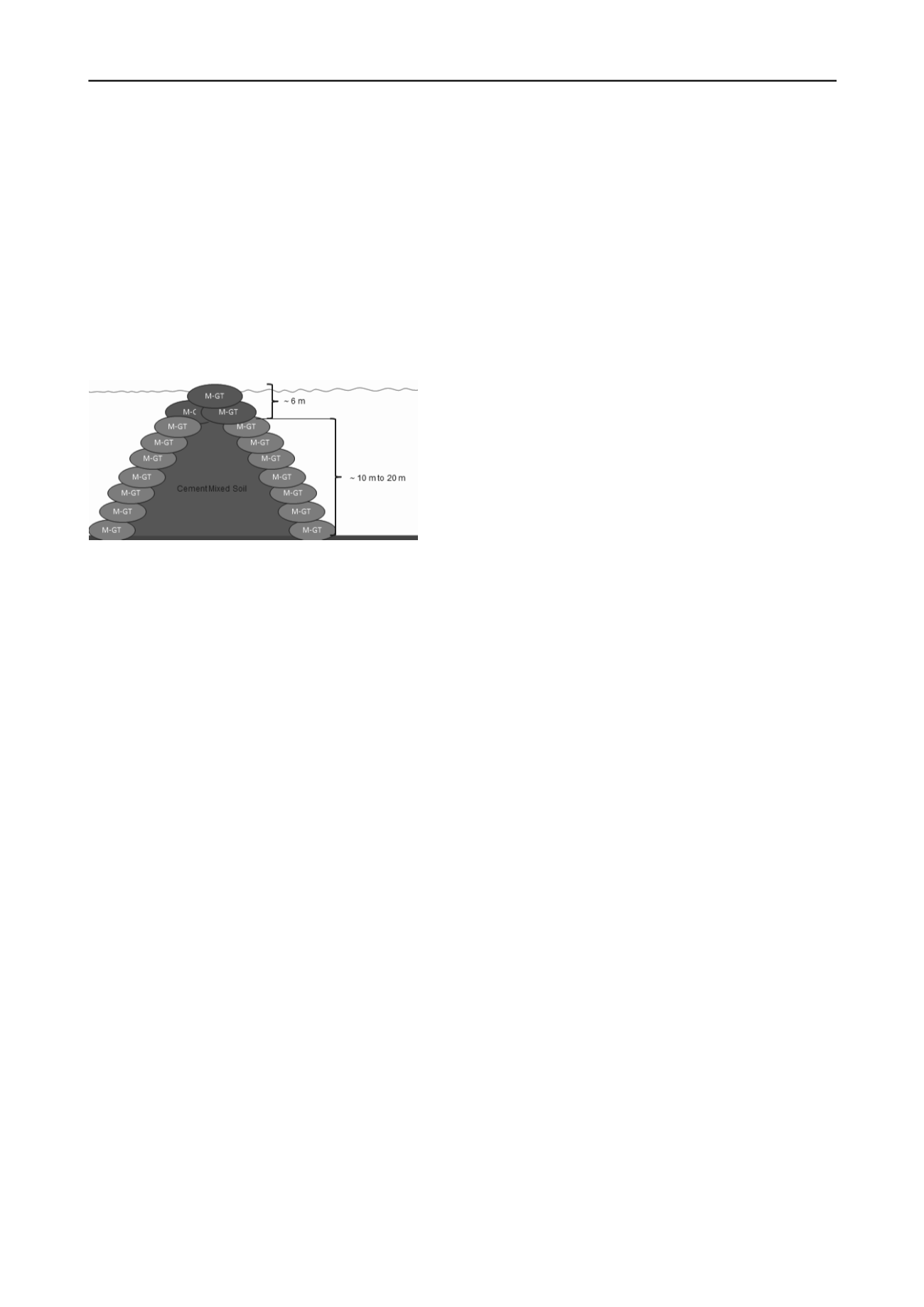
2423
Technical Committee 211 /
Comité technique 211
it is sometimes necessary to resort to additional GI methods in
order to obtain a product meeting the design requirements. The
following paper illustrates how GI and dredging are
complementary construction processes.
Loh et al. (2013)
present considerations in the design and
construction of a containment bund made of modified geotextile
tubes (M-GT) filled with cement-mixed soil. In the port of
Singapore, dredged soil mixed with cement was used as in-fill
material in the M-GT’s and as the core of a large geotextile
containment bund, as illustrated in Fig. 7. Field instrumentation
and monitoring were carried out with the help of strain
measurements, hydrographic survey, inclinometers and
extensometers during and after the construction to verify the
design and the performance of the system.
Figure 7. Geotextile containment bund, from Loh et al. (2013)
4.3
Recent advances in the jet grouting applications
If special devices have been developed in the past to measure
the diameter of the jet grout columns executed in situ,
considerable effort should be made in the understanding of the
physical processes governing this parameter.
Bzówka et al.
(2013)
analyze excavated jet grout columns. The experimental
results are used to model the bearing capacity of the columns by
means of the Z-soil software. Indeed, although the jet grout
columns have been realized in compacted medium sand
underlain by stiff clay, almost all columns had an irregular
shape influencing its bearing capacity.
In the grouting applications, the bleed capacity is another
indicator of grout effectiveness, since it is representative of the
volume of voids filled by cement. The grout’s water-to-cement
ratio (W/C) and the maximum cement grain size (d
max
) are two
important parameters controlling the cement grout bleed
capacity.
Pantazopoulos et al. (2013)
provide some insights on
the effect of grout bleed capacity on the mechanical properties
of ordinary and microfine cement grouted sands, in conjunction
with the effect of the W/C ratio. They demonstrate that the
distinction between stable and unstable grouts (see EN 12715)
may not be an indicator of grout effectiveness since similar
effects may be produced by both stable and unstable grouts: e.g.
same coefficients of permeability were obtained for a bleed
capacity ranging from 5 (stable) to 30 % (unstable suspension).
Bleed capacity correlates very well with some grouted sand
properties (i.e. unconfined compression strength and cohesion)
and not at all with other properties (i.e. internal friction angle
and damping ratio).
5 EARTH REINFORCEMENT
5.1
Geosynthetics
Centrifuge tests have been performed by
Bo et al. (2013)
in
order to study the reinforcement of low plastic brown weathered
shale with polypropylene fibers for the construction of an
embankment. Vertical and horizontal displacements deduced
from the centrifuge tests have been compared with those
obtained from FEM analyses. Both approaches demonstrate the
contribution of the fibers on the stability.
In a similar way,
Tabarsa and Hajiesmaeilian (2013)
have
studied the influence of sand encapsulated non-woven
geotextile (sandwich technique) on the stability of clay
embankment. Using FLAC 2D Finite Difference model, the
authors highlight the efficiency of the method with regard to the
geotextile-reinforced and the unreinforced embankments.
5.2
Vegetation methods
A significant element in the reclamation of landfills is the
reinforcement and biological stabilization of the slopes which
can be very sensitive to surface erosion. According to
Koda
and Osinski (2013)
, landfill stability improvement activities
can be divided in two phases: the first one consists in the
technical reclamation of the landfill and the second one is the
biological restoration of the vegetation cover. For both phases,
the authors argue it is possible to use recyclable materials such
as fly ash or sewerage sludge. They discuss the improvement of
slope stability of a solid waste disposal with the help of this
approach. On the one side, fly ashes can be considered as
impermeable and present good compaction properties. Mixed
with cohesive soil, it could be therefore used for the capping of
the waste disposal. On the other side, the sewage sludge protects
the seeds from erosion and excessive drying. Moreover the
sewerage sludge presents a high nutrition content supporting the
development of the vegetation cover. Unfortunately, no
information is given in the paper concerning the installation
procedures of the fly ashes and sewerage sludge and how the
influence of vegetation can be introduced in the stability
calculations.
6 CONCLUSIONS
In the present General Report, 47 papers of the Technical
Session on GI of the XVIII ICSMGE are reviewed. It can be
noted that 40% of these papers deal with Deep Mixing and soil
stabilization, proving the huge interest in these techniques.
Similar percentage was already observed in the Proceedings of
the TC211 IS-GI 2012 (Denies and Huybrechts, 2012) but this
is not surprising, as these methods constitute outstanding and
cost-effective sustainable construction processes.
Finally, beyond the choice of the GI solution, the necessity
of monitoring was also highlighted by several authors of this
Technical Session. For example,
van der Stoel et al. (2013)
discuss a well-documented case history concerning the
realization of two deep excavations in the courtyards of a
historical building in Amsterdam. Based on 2D FEM
calculations, an extensive monitoring program has been
proposed and performed (including levelling point
measurements, inclinometers and the use of a permanent
webcam). Thanks to this monitoring process the consequences
of two important accidents during the execution of the
excavations could be limited as much as possible. Most
important was that the time delay remained very small. The
authors conclude that the costs of the meticulous and proactive
monitoring were minor in comparison with the potential costs of
a delayed opening of the hotel.
If ground improvement is really become an efficient and
controllable cost-effective alternative to classical foundation
technique, measure still remains treasure.
7 ACKNOWLEDGEMENTS
The authors wish to thank the chairmen of the TC211 Jan
Maertens and Serge Varaksin for their contribution to the
review of the papers of the Technical Session on GI works.


